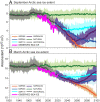A weakened AMOC may prolong greenhouse gas-induced Mediterranean drying even with significant and rapid climate change mitigation
- PMID: 35994643
- PMCID: PMC9436360
- DOI: 10.1073/pnas.2116655119
A weakened AMOC may prolong greenhouse gas-induced Mediterranean drying even with significant and rapid climate change mitigation
Abstract
The Mediterranean region has been identified as a climate hot spot, with models projecting a robust warming and rainfall decline in response to increasing greenhouse gases. The projected rainfall decline would have impacts on agriculture and water resources. Can such changes be reversed with significant reductions in greenhouse gases? To explore this, we examine large ensembles of a high-resolution climate model with various future radiative forcing scenarios, including a scenario with substantial reductions in greenhouse gas concentrations beginning in the mid-21st century. In response to greenhouse gas reductions, the Mediterranean summer rainfall decline is reversed, but the winter rainfall decline continues. This continued winter rainfall decline results from a persistent atmospheric anticyclone over the western Mediterranean. Using additional numerical experiments, we show that the anticyclone and continued winter rainfall decline are attributable to greenhouse gas-induced weakening of the Atlantic Meridional Overturning Circulation (AMOC) that continues throughout the 21st century. The persistently weak AMOC, in concert with greenhouse gas reductions, leads to rapid cooling and sea ice growth in the subpolar North Atlantic. This cooling leads to a strong cyclonic atmospheric circulation anomaly over the North Atlantic subpolar gyre and, via atmospheric teleconnections, to the anticyclonic circulation anomaly over the Mediterranean. The failure to reverse the winter rainfall decline, despite substantial climate change mitigation, is an example of a "surprise" in the climate system. In this case, a persistent AMOC change unexpectedly impedes the reversibility of Mediterranean climate change. Such surprises could complicate pathways toward full climate recovery.
Keywords: AMOC; Mediterranean; climate; mitigation; rainfall.
Conflict of interest statement
The authors declare no competing interest.
Figures






References
-
- Otto F. E. L., et al. , Anthropogenic influence on the drivers of the Western Cape drought 2015–2017. Environ. Res. Lett. 13, 124010 (2018).
-
- Swain D. L., Langenbrunner B., Neelin J. D., Hall A., Increasing precipitation volatility in twenty-first-century California. Nat. Clim. Chang. 8, 427–433 (2018).
Publication types
MeSH terms
Substances
LinkOut - more resources
Full Text Sources
Medical

